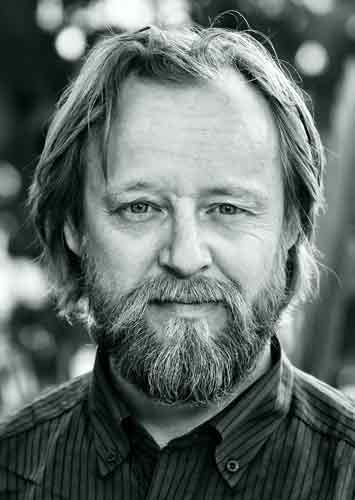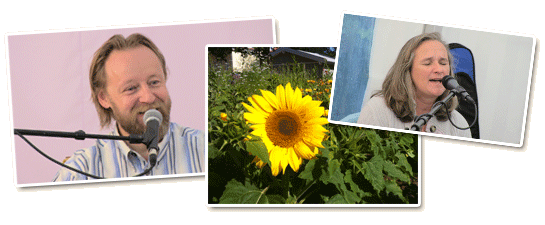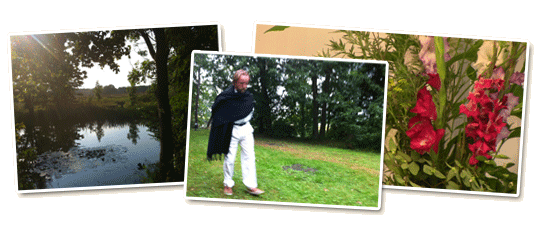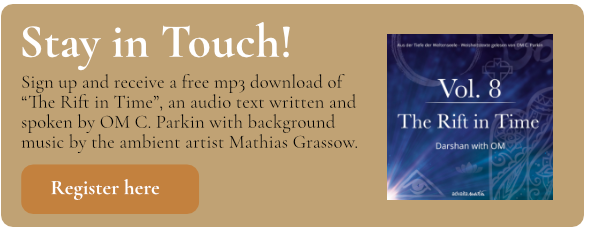
The Great Stillness
For the opening of Silent Love Silent Retreat in 2011 OM C. Parkin speaks about The Great Stillness.
Welcome to Darshan.
I would like to talk about the Great Stillness.
 It is the greatest gift for a human being to spend life in the Great Stillness. The Great Stillness is beyond speaking and beyond silence. The Great Stillness is beyond the world and this side of the world. When we hear stillness, we first understand relative forms of stillness. Relative forms that are actually forms of silence, but not necessarily of stillness and certainly not of what I call the Great Stillness. And yet, all these relative forms of stillness that we also visit when we temporarily leave the surges of the superficial world, are pointing the way to the Great Stillness. Just like all concepts that actually name the Absolute, we cannot understand, analyze, rationalize, or grasp the Great Stillness. Actually, the Great Stillness is a term for God. Just as the term God is a term for the noumenal, for the absolute, the beyond, that which is lost to us in the preoccupation of a partly trivial life on the surface. When we live a life in the Great Stillness, we are no longer in stillness, but everything is in that stillness. The world is dissolved in this stillness. If we live an active and dynamic life, which is actually the rule for Western people of our time, then this dynamism is at best an expression of liveliness, at best an expression of strength and of being in the middle of the world. But all too often it happens to us that it is precisely this activity, which we describe with the term "daily life” that leads us away from the awareness of inner stillness, which can be a signpost towards the Great Stillness.
It is the greatest gift for a human being to spend life in the Great Stillness. The Great Stillness is beyond speaking and beyond silence. The Great Stillness is beyond the world and this side of the world. When we hear stillness, we first understand relative forms of stillness. Relative forms that are actually forms of silence, but not necessarily of stillness and certainly not of what I call the Great Stillness. And yet, all these relative forms of stillness that we also visit when we temporarily leave the surges of the superficial world, are pointing the way to the Great Stillness. Just like all concepts that actually name the Absolute, we cannot understand, analyze, rationalize, or grasp the Great Stillness. Actually, the Great Stillness is a term for God. Just as the term God is a term for the noumenal, for the absolute, the beyond, that which is lost to us in the preoccupation of a partly trivial life on the surface. When we live a life in the Great Stillness, we are no longer in stillness, but everything is in that stillness. The world is dissolved in this stillness. If we live an active and dynamic life, which is actually the rule for Western people of our time, then this dynamism is at best an expression of liveliness, at best an expression of strength and of being in the middle of the world. But all too often it happens to us that it is precisely this activity, which we describe with the term "daily life” that leads us away from the awareness of inner stillness, which can be a signpost towards the Great Stillness.
God is a term that is burdened with many thousands of years of Christian imprinting, burdened with theological interpretations, misinterpretations, and misunderstandings. And yet I have returned to this concept because, if we let it work in depth, it can bring about something unnameable in a Christian person, can bring about something indescribable, can touch and open something beyond the rational understanding of this thinking mind. And nevertheless, when we hear about the Great Stillness, we perceive that this concept is empty, unencumbered, unstamped by millions of years of history of this earth. Somehow this concept touches without detours, in a direct way the emptiness, the beyond. And it is a concept that corresponds to this path, which is a pure path of experience, quite in contrast to the outer religions that create myths of faith, temporary divine images and conceptions that are meant to lead you deeper in the end through your faith, through your devotion, through your heart opening. However, if we take the path of experience, which I also call the direct path, we do not believe in God, just as we do not doubt God. We leave behind the God of faith, which ultimately means that we leave behind all religious concepts. In a Christian context, it seems downright blasphemous for me wanting to speak of an experience of God.
When I say it this way, it turns out that this very concept is loaded. That is the shadow side of this God, who no longer penetrates directly into the heart of a human being, but who has to make his way through all the layers we have accumulated, of concepts, of ideas, of judgments. Stillness, however, can be relatively experienced by every human being.
How deep the experience of inner stillness can go, how deep this fall into the Great Stillness can be, is a question of one’s letting go. And letting go describes an act of dying during physical life. This inner act of dying that leaves behind the world and with it the ‘I’ that lives in the past, leads naturally into an experience of inner stillness. Stillness begins where the movement of the surface on which we live, becomes quieter in the depths, until it flows into stillness. Stillness, then, is not simply a theoretical concept. When the sages, when the seers, the mystics spoke of the Great Stillness, ultimately using it to refer to God, they were referring to a sacred experience marked by infinite stillness. It is not an inanimate, lifeless, or dead stillness. When we speak of God, when we speak of the Absolute, when we speak of the Unnameable, of that which cannot actually be put into words, we must stop giving it certain attributes, that we can understand. Attributes like alive or dead, attributes like low or high, like light or dark. All these attributes can no longer be used for THAT, even if we try. So it is untrue to say that the Great Stillness is alive, just as it is untrue to say that the Great Stillness is dead. It is beyond the imaginative capacity of linear thinking that there is a world, that there is a realm, a way of being, that is simultaneously dead and alive, not alternately, not side by side, but simultaneously and within each other, that is simultaneously dark and light and thus neither dark nor light. And if it is simultaneously dead and alive, it is neither dead nor alive.
It has been an experience for generations of interested inner human beings who have followed a path that has been pointed out to them, that seeking out relative stillness can bring about an opening into the Great Stillness. Even when, as every meditator knows, this opening can initially produce increased inner noise. That means, that this ascetic aspect of the path knows the value of what it means to leave the world behind again and again, and with the world, the entanglement into the world. For the world is not only the thinking that populates our consciousness like a dense surface, no, it is the thinking that is master of the senses of this body. That is, seeing with these eyes, hearing with these ears, touching with these hands, tasting with this mouth, all this is not separate from this intransparent layer of thought that populates our superficial consciousness. Rather, it is done in the service of this opaque layer of thoughts. However, when we close our eyes, when the day comes to rest, when night falls, if we don't get scared which is the other side of it, we sometimes experience a very natural inner stillness. It is exactly the same when we walk through a cemetery. The presence of death, that is, the relative absence of the active world opens a space of stillness within us. So it is indeed like that, and it is not a new experience, but an experience that has been shared by generations of inner human beings, that relatively leaving the world, temporarily leaving the world represents a great value for the human being interested in having the inner eyes opened. Perhaps we can go so far as to say that it is indispensable to leave the world. Now, leaving the world is of a much broader nature than we first think. With leaving it we also leave the entanglements in the world, the attachments, the suffering, the entanglements with trivialities, which we often find at the center of our attention.

When our consciousness is beset by impressions throughout the waking state and additionally during periods of sleep at night, when we are exposed day in and day out to a flood of inner impressions brought in through the senses, our perception is in a highly coarsened, actually dulled mode. This aspect of dullness is an aspect that can be confirmed at any time by explorers of the experiential path. The consciousness is dulled by a flood of coarse impressions to which we constantly expose ourselves. People who are physically on the move from morning till night, who are only working, who on the other hand are only pursuing their pleasure or the like, who are busy at all times, just like some false meditators who have renounced the outer world but are inwardly fully exposed to the intransparent stream of thoughts, all those experience a strong coarsening of their perception and thus ultimately a darkening of consciousness. We must be fundamentally aware of this, be aware of what it means, what its implications are, what its consequences are for our perception,if we constantly expose ourselves to this inner and outer coarsening. We are not used to advance into the innermost subtlety, which means also to leave behind the gross material sphere, to enter a subtle world, to enter a spiritual world and ultimately to enter consciousness itself. Our mind, which is used to living in the gross material world, reacts with fear when a movement takes place that leaves this world. Meeting this fear and being in contact with it, attending it and ultimately seeing through it is thus a great obstacle for people on the one hand, and on the other hand a great gate through which we have to pass, because it is this fear that keeps holding us back again and again. The gross is the known, the known is also the darkening and the coarsening of consciousness. We cannot imagine the subtlety, the absolute subtlety of consciousness necessary to truly perceive reality. Our methods of perception are often far too coarse and correspond to modern, industrial fishing methods that move through the seas with large fishing nets. Only the biggest, supposedly juiciest and fleshiest fish get caught in these meshes. No, we need a much more targeted, precise, inner methodology of perception. Dragging through the seas with trawls and huge meshes may still be sufficient for discrimination in the gross material world. However, if we are really interested in reality - reality opens the Great Silence - we need a methodology highly refining our perception. For this refinement to become possible, it is necessary to access the state of meditation.
The Advaita tradition has a very radical concept of meditation, not fifteen minutes, not one hour a day, but twenty-four hours a day. That was what my teacher always emphasized. So we understand that meditation is a state of consciousness that we have to go to, that we have to grasp, realize, experience, beyond all our physical postures, our work, our speaking or our silence, and beyond the events of our daily life. Leaving the world is much more encompassing than we think. Leaving the world would mean that the world has come to an end at this point. I don't see people in the state of being ready for the world to end completely at this point. No, they just keep working, they keep going, they live a life in time. But I have always talked about being ready for the end. It seems to be hard in a modern world where all people are basically materialistically oriented and that doesn't refer to external matter. No, it is a form of thinking, a form of having, a form of wanting to have, a form of possessing and holding. All this is part of a materialistic world. It is hard for a person who lives this concept to really realize the end of the world, to be ready for it. The end of the world, that is the end of your personality as well, it is the end of this person as you have known it. There is actually this moment where a rift goes through this human being and this rift is the end. And we don't know anything of what may happen then. We don't know what will go on in that person, who will not be the same as before. After passing through this rift no person was the same as before. The world does not continue as we believe. Life is not a continuum of time as we believe it is. It is not a continuum of past, present and future. That is a construct of our thinking: we live in this world and we believe, our life happens in this world. And in this world, we can't imagine that something has ended, that everything that existed has ended, and that from this end the unknown emerges, the new, the next moment. We cannot imagine what it means to live like this, because it is not Life as we know it. Because I said before, if we want to approach reality, we have to stop thinking in such attributes. I want to say life, real life, would no longer be life as opposed to death, but real life, true life would be living and dying simultaneously. It would be a life in which dying would take place every moment and in which living and dying, designating also the real processes, are no longer separated. That is, we would live in a state in which living and dying happen simultaneously. In such a state, the world, as it existed in our mind, can no longer persist. The world can only continue because we have separated living and dying and because we think we are living our lives and today I am 40 years old, and next year I will be 41 years old, my name is so and so and sometime in the future I'll just die. This is how ordinary people think, this is how they live, this is THEIR life. This is a totally different way, a totally different perspective, a perspective that is interested in reality and not in the personal dream that people believe to be life itself. So, if this moment was actually life and death at the same time the world could not go on existing in your mind as it does. It would die so to speak every moment and be born again every moment. So this is a state of Being at the Source and much of our effort on the path is concerned exclusively with how we avoid drinking from that Source and how we avoid allowing that ultimate understanding and how, by unswervingly holding on to the old, we want to continue the world as we believe it has always been and thus continue ourselves as we believe we have always been.

True transformation is a rare happening. The difference between true transformation and ordinary processes of change that people go through along the way, changes like "I used to be afraid in the elevator and now I feel better in the elevator," changes like "I used to hate my mother and now I can forgive her," are not transformation. These are harmless changes within the illusory world of the mind. They are nevertheless changes that we may have to go through because they help us open our eyes imcreasingly. But transformation, unlike all the processes of change we go through, is a death process. That is, a process in which something comes to an irrevocable end, completely sinking into nothingness without even leaving a trace behind. This is a process of transformation and a person who is not ready to allow to the bottom such a radical process, goes through many, partly positive changes in this life, without real knowledge of the Absolute, without knowledge of the Great Stillness. If we are really interested in the Great Stillness, in the eternal stillness, in the dead-alive, eternal stillness, we need the willingness to go through such a process of transformation, through a death process. And this process of death brings with it many things, in fact almost everything that we cannot foresee. That means you give your life out of your hands, it is not obvious any more how your life will continue. It is not obvious what your tasks are, it is not obvious how you are and it is not obvious who you are. All this is no longer obvious. You surrender to this fall, implemented by the great power, and in this, transformation happens naturally, just as it happens on a different level in physical death. What has gone through such a process is no longer the old. It is no longer as it was before, and it no longer refers to that which was before yet something is preserved, and that which is preserved is what already shone through before: that which is true, beautiful and good in the soul of the human being. This already shone through before the process of transformation carried away with it everything of the darkening of consciousness that covered it, so that the eyes could not distinguish it. When we are free from all obscuration, we live the great stillness. Paradoxically, it is parts of the colorful life and its colorful impressions sometimes nourishing our greed for life that can contribute to the darkening of consciousness. This is the reason why it is so valuable to also leave the world again and again in consciousness as happening on a silent retreat.
Darshan excerpt, 28th of July 2011
